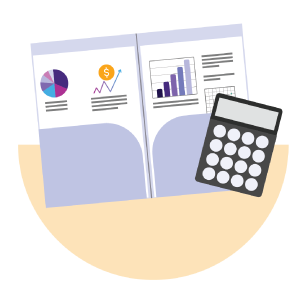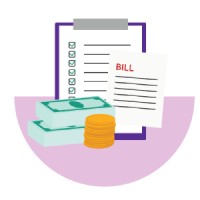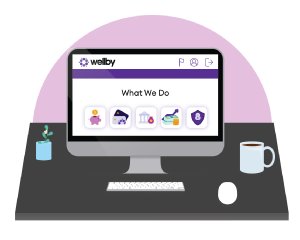February 6, 2025 | by Brian Truong

How to Create a Budget: An Easy Step-by-Step Guide
January 30, 2024
By The Team at Wellby
 The roadmap to financial wellness starts with effective budgeting. Budgeting helps you manage your finances better, which offers a cushion against unexpected expenses, allowing you to enjoy a healthier financial life. In addition, a budget provides a clear understanding of your financial situation, enabling you to make more informed decisions on purchases and investments. This way, you're more empowered to set and achieve short-term and long-term financial goals.
The roadmap to financial wellness starts with effective budgeting. Budgeting helps you manage your finances better, which offers a cushion against unexpected expenses, allowing you to enjoy a healthier financial life. In addition, a budget provides a clear understanding of your financial situation, enabling you to make more informed decisions on purchases and investments. This way, you're more empowered to set and achieve short-term and long-term financial goals.
In a nutshell, budgeting is a core component of financial planning. Learning how to create a budget is fundamental to maintaining and improving your financial health. Whether your goal is to maintain financial stability, save more for retirement, or achieve financial independence and retire early, budgeting provides much-needed control over your finances.
Keeping track of your expenses minimizes the risk of overspending, enabling you to manage your money more effectively. As a result, you're more empowered to manage your debts and save more, leading to less financial stress. As statistics indicate, more than 40% of Americans with a financial plan save 50% more monthly.
This article provides a step-by-step guide on creating a budget, including understanding your financial situation, setting up your budget plan, tips for effective budgeting, and common budgeting challenges and solutions.
Understanding Your Financial Situation
Before you start budgeting, you need to understand your financial situation. This involves three steps: assessing your income, creating a list of your monthly expenses, and identifying your short-term and long-term financial goals.
Assessing Your Income
 Budgeting is based on income. Determine how much you make each month by listing all your income sources to derive your gross earnings. If you don't have a regular income, i.e., the earnings vary every month, you can work with an average. For instance, sum up your income for three months and divide by three to get a monthly average.
Budgeting is based on income. Determine how much you make each month by listing all your income sources to derive your gross earnings. If you don't have a regular income, i.e., the earnings vary every month, you can work with an average. For instance, sum up your income for three months and divide by three to get a monthly average.
If you're self-employed or have a side business, you should deduct all the business expenses from the gross income to get the net figure (taxable income). Then, you calculate the taxes payable using the applicable rates and deduct the amount to arrive at your discretionary income. Discretionary income is the money available for spending, saving, and investing. On the other hand, if you receive a paycheck, your employer automatically deducts taxes and other obligations (health insurance, 401(k), etc.), so the amount you receive is your discretionary income.
Creating a List of Your Monthly Expenses
 Next, estimate your monthly expenses. Track your monthly expenditure by listing your fixed and variable expenses and determine how much you spend on each category. Fixed expenses are the expenditures that are consistent from month to month, while variable expenses are more flexible.
Next, estimate your monthly expenses. Track your monthly expenditure by listing your fixed and variable expenses and determine how much you spend on each category. Fixed expenses are the expenditures that are consistent from month to month, while variable expenses are more flexible.
Examples of fixed expenses
- Rent or mortgage
- Insurance payments (health, auto, home, etc.)
- Car payments
- Utility bills (water, electricity, internet, etc.)
Examples of variable expenses
- Food
- Travel
- Entertainment
For variable expenses, sum up the total for several months and divide by the number of months to get an average. Lastly, don't forget to account for irregular (e.g., semi-annual and annual) expenses such as car registration.
Identifying Financial Goals
 Setting up financial goals is essential for long-term financial stability. Identifying your short-term, mid-term, and long-term financial plans allows you to set aside resources and make necessary adjustments to your lifestyle to achieve them. Short-term goals are those you can achieve in a year or less, and mid-term goals can be realized in 1-5 years, while long-term goals require five years or more to attain.
Setting up financial goals is essential for long-term financial stability. Identifying your short-term, mid-term, and long-term financial plans allows you to set aside resources and make necessary adjustments to your lifestyle to achieve them. Short-term goals are those you can achieve in a year or less, and mid-term goals can be realized in 1-5 years, while long-term goals require five years or more to attain.
Examples of goals
- Saving for retirement
- Saving for a vacation
- Paying off debt (student loan, mortgage, credit card debt, etc.)
- Setting up a business
- Purchasing a home
- Enrolling in college
- Creating an emergency fund
Set clear financial goals and categorize them in order of priority.
Setting Up Your Budget Plan
 Once you've identified your financial goals, you're ready to create your budget plan. To get started, it's vital you understand your needs vs. wants and prioritize spending. Do a thorough audit of your spending habits to identify unnecessary expenses you may need to cut back and channel the resources towards your goal.
Once you've identified your financial goals, you're ready to create your budget plan. To get started, it's vital you understand your needs vs. wants and prioritize spending. Do a thorough audit of your spending habits to identify unnecessary expenses you may need to cut back and channel the resources towards your goal.
Needs are necessities essential for your day-to-day life, while wants are expenses that improve your quality of life but you can live without.
Examples of needs
- Food
- Housing
- Utility bills
- Housing
- Work or school uniform
- Insurance
- Transportation
Examples of wants
- Gym memberships
- Entertainment
- Luxurious vacation
- Designer clothing
- Dining out
Once you understand your needs vs. wants, you can then make the necessary adjustments to your spending based on your discretionary income to accommodate your financial goals. For instance, you may decide to do away with your gym membership, move to a less expensive house, trade in your expensive car for a more affordable model, etc., to free more resources.
What Is the 50/30/20 Rule and How Do You Use It?
 The 50/30/20 rule is a budgeting approach that guides how to split discretionary income between needs, wants, and savings. According to the rule, you should allocate 50% of your income to needs, 30% to wants, and 20% to savings.
The 50/30/20 rule is a budgeting approach that guides how to split discretionary income between needs, wants, and savings. According to the rule, you should allocate 50% of your income to needs, 30% to wants, and 20% to savings.
Depending on your income, you may be able to allocate more than 20% to savings, but the rule is a basic guideline to get you started. This means, at the most basic, expenses should not exceed 80% of your budget. The other 20% must be set aside to fund your financial goals.
Allocating Funds to Different Categories
The final step is allocating funds to the different categories – needs, wants, savings, and debt repayment. It's worth mentioning that monthly budgeting may seem daunting at first, but it's essential to ensure you're not falling back on your financial goals. Besides, it becomes easier and more fulfilling once you get used to it.
Use the 50/30/20 rule to allocate funds to needs, wants, and savings. Minimum debt repayment should fall under the 50% allocation, but you can cut back on some of your wants to pay off the obligations much faster. Prepaying debts may attract interest cuts, leaving you with more money for savings.
Tips for Effective Budgeting
 As mentioned, once you master budgeting, it gets easier and more fulfilling, especially as you start realizing the outcome of your efforts. If you're getting started, however, here are proven tips you can leverage for effective budgeting.
As mentioned, once you master budgeting, it gets easier and more fulfilling, especially as you start realizing the outcome of your efforts. If you're getting started, however, here are proven tips you can leverage for effective budgeting.
- Track expenses: Effective budgeting requires a clear picture of your spending habits to identify unnecessary expenditures and free more resources to meet your goals. There are handy tools and methods for tracking expenses, such as Spreadsheets, mobile apps/online software, or the envelope method (categorizing your expenses and then putting money for each in individual envelopes).
- Cut unnecessary expenses: Audit your monthly bills and discretionary spending to find saving opportunities. For instance, you might want to cancel some subscriptions and memberships that you do not need, consolidate debt to reduce interest, minimize takeouts by preparing meals at home, carry packed lunch to work, bundle up your insurance to enjoy discounts, shop for more affordable policies, move to a more affordable neighborhood to reduce rent expenses, etc.
- Save consistently: Start by implementing the 50/30/20 rule and ensure you save before you spend by automating savings. If you have a tight budget, audit your spending habits and cut back as many unnecessary expenses as possible. But if your budget allows, you can keep increasing the percentage and maintain consistency. Having a clear goal before you start saving is also vital – do you want to build an emergency fund, buy a house, save for retirement, purchase a new car, or enroll in college?
- Be flexible: Adhering to your budget is crucial to attaining your goals. However, it's equally important to adjust the budget as life changes. Maybe you have a new income stream, had a pay rise, or even a pay cut. Allowing flexibility in your budget enables you to maximize your income and restrain yourself from overspending. If your income decreases, you also need to make necessary adjustments to create a balance and avoid potential financial distress, which can be counterproductive to your overall well-being and attainment of goals.
Common Budgeting Challenges and Solutions
 Like any other process, potential challenges may hinder effective budgeting. But they're not insurmountable. Below, we share the top three challenges of budgeting you're likely to encounter and their solutions.
Like any other process, potential challenges may hinder effective budgeting. But they're not insurmountable. Below, we share the top three challenges of budgeting you're likely to encounter and their solutions.
- Irregular income: If you receive irregular income, you might find sticking to your budget challenging, especially during the low-income months or periods. To overcome this, ensure you save more money during your high-income months to cover for your low seasons.
- Unexpected expenses: Emergencies are part and parcel of life. Though unexpected, you should be prepared to handle them once they arise, e.g., by building an emergency fund. This can be the equivalent of three-six months of your expenses.
- Motivation and discipline: Staying motivated and disciplined is perhaps one of the biggest hurdles to budgeting. The best way to overcome this is by creating realistic budgets and setting clear and achievable saving goals. You might also consider having an accountability partner to review your milestones.
Start Your Path to Prosperity
 If you're starting your budgeting journey, we hope this information has been insightful. Financial literacy is foundational to financial prosperity. That's why, at Wellby Financial, we are committed to providing you with the resources you need to make effective and informed financial decisions.
If you're starting your budgeting journey, we hope this information has been insightful. Financial literacy is foundational to financial prosperity. That's why, at Wellby Financial, we are committed to providing you with the resources you need to make effective and informed financial decisions.
We have divided our Financial Wellness Center into digestible chapters focused on financial literacy and key areas of financial success. Our resources are designed to expand your knowledge and build confidence to guide you on your path to prosperity.
Related Topics
The Team at Wellby is a diverse group that is here to help you find the right financial solutions for your unique goals and budget. Our passion is people: our members, team members, and the communities we serve. We help people find solutions that support their financial well-being, allowing them to dream and prosper.
Related articles you might like
December 23, 2024 | by Brian Truong
Budgeting 101: Comparing Fixed and Variable Costs
December 12, 2024 | by Brian Truong







